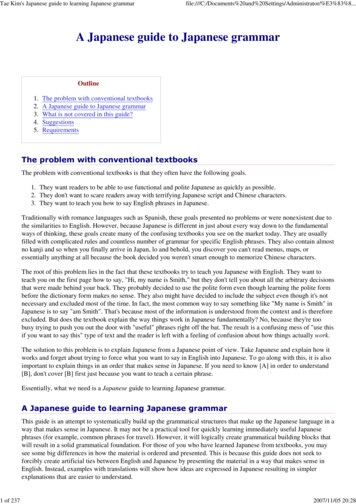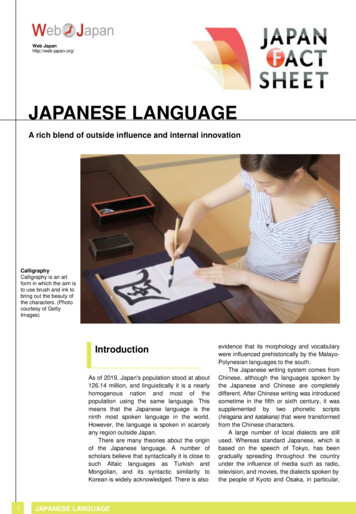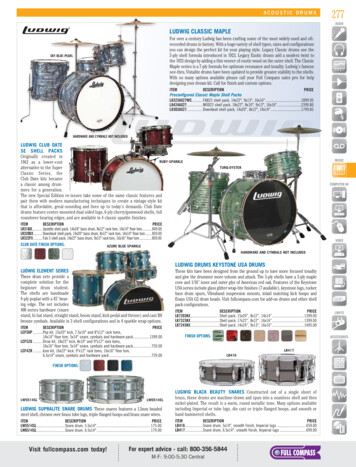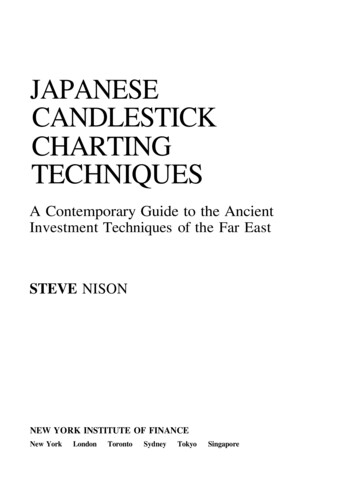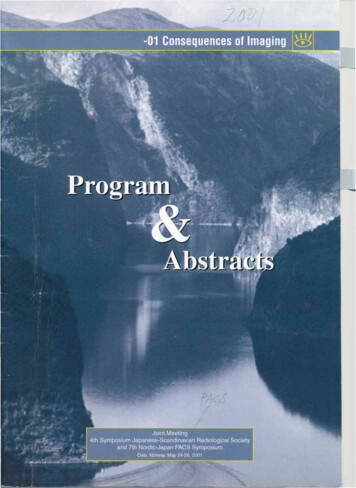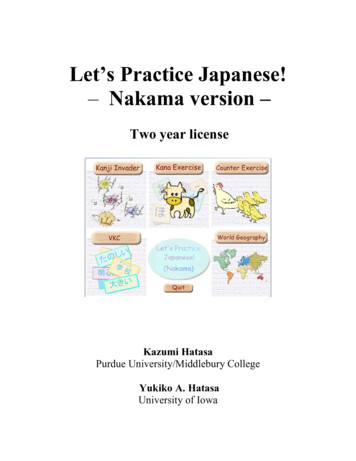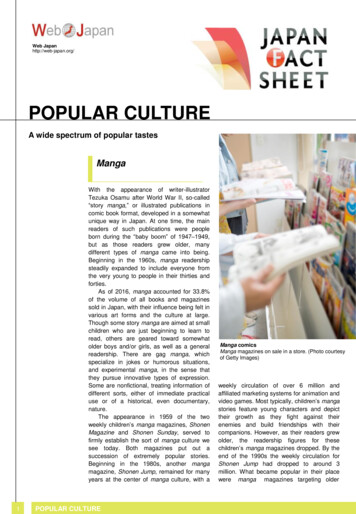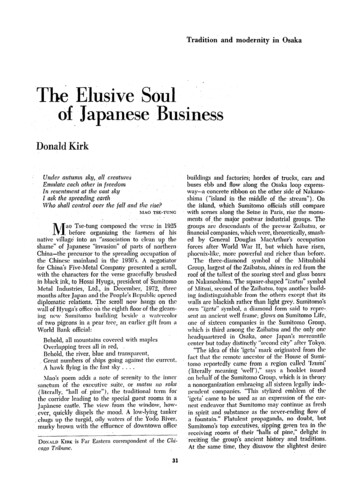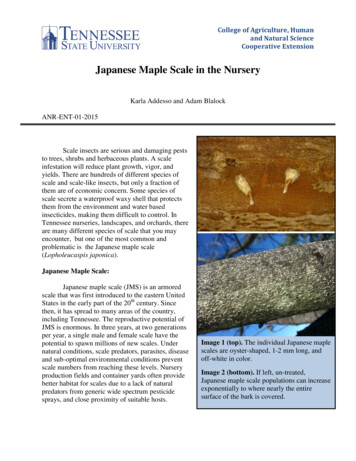
Transcription
College of Agriculture, Humanand Natural ScienceCooperative ExtensionJapanese Maple Scale in the NurseryKarla Addesso and Adam BlalockANR-ENT-01-2015Scale insects are serious and damaging peststo trees, shrubs and herbaceous plants. A scaleinfestation will reduce plant growth, vigor, andyields. There are hundreds of different species ofscale and scale-like insects, but only a fraction ofthem are of economic concern. Some species ofscale secrete a waterproof waxy shell that protectsthem from the environment and water basedinsecticides, making them difficult to control. InTennessee nurseries, landscapes, and orchards, thereare many different species of scale that you mayencounter, but one of the most common andproblematic is the Japanese maple scale(Lopholeucaspis japonica).Japanese Maple Scale:Japanese maple scale (JMS) is an armoredscale that was first introduced to the eastern UnitedStates in the early part of the 20th century. Sincethen, it has spread to many areas of the country,including Tennessee. The reproductive potential ofJMS is enormous. In three years, at two generationsper year, a single male and female scale have thepotential to spawn millions of new scales. Undernatural conditions, scale predators, parasites, diseaseand sub-optimal environmental conditions preventscale numbers from reaching these levels. Nurseryproduction fields and container yards often providebetter habitat for scales due to a lack of naturalpredators from generic wide spectrum pesticidesprays, and close proximity of suitable hosts.Image 1 (top). The individual Japanese maplescales are oyster-shaped, 1-2 mm long, andoff-white in color.Image 2 (bottom). If left, un-treated,Japanese maple scale populations can increaseexponentially to where nearly the entiresurface of the bark is covered.
Japanese maple scale has severalcharacteristics which make it a successful insectpest. One of its advantages is its wide host range,which allows it to spread and establish easily inlandscapes and nurseries. The scale's known hostrange includes trees and shrubs in more than 16genera in 13 families, including: Acer,Amelanchier, Camellia, Carpinus, Cercis,Cladrastis, Cornus, Cotoneaster, Euonymus,Fraxinus, Gledistia, Hamamelis, Ilex, Itea,Ligustrum, Magnolia, Malus, Oxydendrum,Prunus, Pyracantha, Pyrus, Rosa, Salix, Spirea,Stewartia, Styrax, Syringa, Tilia, Ulmus, Zelkova.Image 3. A strong hand lens or dissectionOther woody ornamentals are likely to act asmicroscope is required to see the Japanesehosts.maple scale juveniles, also calledJapanese maple scale is small, measuringcrawlers.only 1-2 mm long. It is off-white in color andoyster-shaped (Image 1). Because of its smallsize and color, JMS can be difficult to see on many trees and shrubs, particularly those with lightcolored or mottled bark. Often, JMS goes unnoticed until large areas of the bark are covered(Image 2). The scale is also fairly cold tolerant, and has been spreading southward into warmerstates in recent years. In colder climates the scale has one generation per year, but it can havetwo in warmer climates, allowing the populations to increase more rapidly followingintroduction.Lifecycle and Activity in Middle Tennessee:The lifecycle and activity pattern of JMS in the southeastern Unites States is notcompletely understood. This makes management decisions difficult. Each female scale laysapproximately 25 eggs which are protectedunder their waxy armor. In middle Tennessee,the first eggs start hatching in early Maycoinciding with the blooming of Japanese lilac(Syringa riticulata ‘Ivory Silk’) and oakleafhydrangeas. From the eggs, small, purple,wingless juveniles called crawlers emerge(Image 3) to seek out new feeding sites on thesurface of the plant. This is the only stage ofJMS that is capable of infesting new plants.The crawlers may be transferred to new plantsby wind or walking onto adjacent, touchingplants. Other species of armored scales havebeen shown to hitch rides on other flyinginsects or birds present on infected plants,Image 4. A good hand lens is required to seesuggesting another possible means of JMSthe winged males. To the naked eye, they candispersal.look like specs of debris or tiny gnats on thesticky trap.
Two to three days after the crawlers hatch, theywill settle, begin feeding, and start secreting their waxarmor. The crawler stage is the most vulnerable stage ofthe armored scale life cycle and therefore the stage oftentargeted for control with contact pesticides. The rapidsecretion of wax by JMS is an additional characteristicwhich makes it a challenging pest to control. Manyarmored scales remain in the unprotected crawler stagefor a week or more, allowing more time for directexposure to the environment. Japanese maple scales havea very short window of vulnerability, both to harmfulnatural conditions and contact insecticides.Recent research out of TSU's Nursery ResearchCenter has confirmed that JMS has two crawleremergence peaks (two generations) per year in middleTennessee fields. Both crawlers and winged males(Image 4) were monitored by placing sticky traps madeof yellow vinyl tape coated in a thin layer of petroleumjelly (Image 5) on infested limbs and branches. The firstgeneration of crawlers was very pronounced, beginningthe second week of May and peaking the third week ofMay, between 801-927 growing degree days (base 50).The second generation was less pronounced and peakedthe last week of August between 2615-3024 growingdegree days. The two generations are overlapping, andImage 5. Simple sticky traps are used towhile crawler numbers decreased sharply in July, theremonitor the Japanese maple scale, andwere still small numbers of crawlers active throughoutother scale species, to determine whenthe summer between peaks (Chart 1). Japanese maplethe mobile crawlers become active.scale crawlers were active for a total of 24 weeks, fromthe second week of May to mid-October. In 2014, wedetected a flight of males in July which peaked between 2306-2441 growing degree days. Anearly spring male flight was observed in 2015 in the first two weeks of April, and began before360 growing degree days. In middle Tennessee, JMS appears to overwinter as immature secondinstars, not mated females. Preliminary work at TSU's Nursery Research Station suggests thatJMS may begin activity much earlier in container production held under winter cover.Control:An annual application of dormant oil has been shown to provide good control for themajority of scale species with complete coverage. In our evaluation, 30 days after dormant oilwas sprayed, the percent of live JMS significantly fell from around 60% to 15% (Table 1).However, many nursery growers have reported that a single, annual, application of dormant oil isonly providing satisfactory JMS control after years of observations. Other scale species that haveonly one generation per year might be effectively controlled with this one annual application ofdormant oil, but JMS has two generations per year. JMS is also small, able to hide in barkfissures and under mulch and leaf litter around the root zone. The individual scales that escape
the dormant oil spray are able to reproduce not just once, but twice, meaning that by the end ofthe season, JMS populations can potentially rebound to the level they were prior to the dormantoil spray. Dormant oil sprays are still effective and recommended but for JMS, but anothercontrol method should be employed to gain control of the infestation.From our foliar insecticide sprays, one of the most effective chemicals for reducing thescale population was to spray an insect growth regulator (IGR) such as Fulcrum (pyriproxifenbeing the active ingredient). IGRs work best on scale when sprayed directly on the crawlers, thusconfirming the importance of monitoring your scale infestation by setting sticky traps andwaiting for the crawlers to emerge. IGRs are also less toxic to beneficial insects like lady beetles,lacewings, and honey bees because these insects are already in their adult stage. Other IGRsinclude Distance and Talus . A 0.5-1% summer oil application is recommended incombination with the IGRs because it aids in the spread of the chemicals. Additionally, we haveshown that an oil application will loosen the scale covers, allowing for a more synchronousemergence of crawlers - bringing more of them in direct contact with the IGR.JMS can also be managed through the use of soil applied systemic drenches. Discus (imidacloprid being the active ingredient) provided the best results from our systemic soildrenches at the end of our first year of monitoring. Imidacloprid drenches do significantly reducethe number of live scales but they do not completely eliminate them in the first year. By yeartwo, however, imidacloprid treated trees had no visible signs of JMS. For thick evergreen plantslike hollies and southern magnolias which are difficult to penetrate with dormant oil, a systemicdrench may further reduce the scale population. Pesticide trials for this insect are ongoing, andnew findings will be added to this publication as they become .60.40.206-May6-Jun6-Jul6-Aug6-Sep6-OctChart 1. In 2014, the first generation of JMS crawlers (blue line) began to emerge between May13th and May 21st in McMinnville, TN with peak activity occurring the following week. Notethat the second generation of crawlers overlapped slightly with the first generation; it peakedbetween August 13th and August 29th. Winged males (green line) began to emerge between April6th and April 13th (obtained through 2015 monitoring – not displayed on the chart above) andagain on July 3rd.
Table 1. Chemical Treatment EvaluationsProductDormant OilApplication TimingSpring/Fall above 60⁰FInsect GrowthRegulator (Fulcrum,Distance, Talus, etc.)Summer; peak crawleractivity in late May/ lateAugustChlorpyrifos(Duraguard ME, etc.)Summer; peak crawleractivity in late May/ lateAugustSpring drenchImidacloprid(Discus N/G, etc.)Dinotefuran(Safari SG 20, etc.)Spring drenchSummer OilSummer; peak crawleractivity in late May/ lateAugustInsecticidal Soap(M-Pede, etc.)Stage EffectedControl LevelAdults/2nd instars Good for suppression;fall application willincrease wintermortality; springapplication willsuppress firstgenerationreproductionCrawlersExcellent; IGRsprevent immaturecrawlers from reachingadult stageCrawlersVery Good; controlequivalent to IGRs inone trialAdults/CrawlersVery Good; slowacting suppression infirst year; control insecond; may preventcrawler establishmentAdults/CrawlersQuick suppression offirst generation;ineffective after 90days in field trees; usein combination withother control methods;summer trunk sprayswere ineffectiveCrawlersPoor; use 0.5 - 1% oilin combination withIGRs and otherinsecticides to loosenscale covers;ineffective controlwhen used aloneNo control observed
For additional information, contact your local nursery specialist office at:Tennessee State UniversityCollege of Agriculture, Human and Natural Sciences3500 John A. Merritt Blvd., Box 9635Nashville, TN 3720 -1561http://www.tnstate.edu/extensionTennessee State University, Otis L. Floyd Nursery Research Center472 Cadillac Lane McMinnville, TN tionary StatementTo protect people and the environment, pesticides should be used safely. This is everyone’sresponsibility, especially the user. Read and follow label directions carefully before you buy,mix, apply, store or dispose of a pesticide. According to laws regulating pesticides, they must beused only as directed by the label.DisclaimerThis publication contains pesticide recommendations that are subject to change at any time. Therecommendations in this publication are provided only as a guide. It is always the pesticideapplicator’s responsibility, by law, to read and follow all current label directions for the specificpesticide being used. The label always takes precedence over the recommendations found in thispublication. Use of trade, brand, or active ingredient names in this publication is for clarity andinformation; it does not imply approval of the product to the exclusion of others that may be ofsimilar and suitable composition, nor does it guarantee or warrant the standard of the product.The author(s) and Tennessee State University assume no liability resulting from the use of theserecommendations.TSU-15-0119(A)-10-61065 – Tennessee State University does not discriminate against students,employees, or applicants for admission or employment on the basis of race, color, religion, creed,national origin, sex, sexual orientation, gender identity/expression, disability, age, status as a protectedveteran, genetic information, or any other legally protected class with respect to all employment,programs and activities sponsored by Tennessee State University. The following person has beendesignated to handle inquiries regarding non-discrimination policies: Tiffany Cox, Director, Office ofEquity and Inclusion, tcox9@tnstate.edu, or Justin Harris, Assistant Director, Office of Equity andInclusion, jharri11@tnstate.edu, 3500 John Merritt Blvd., McWherter Administration Building, Suite 260,Nashville, TN 37209, 615-963-7435. The Tennessee State University policy on nondiscrimination can befound at www.tnstate.edu/nondiscrimination.
control method should be employed to gain control of the infestation. From our foliar insecticide sprays, one of the most effective chemicals for reducing the scale population was to spray an insect growth regulator (IGR) such as Fulcrum (pyriproxifen being the active ingredient). IGRs wor
